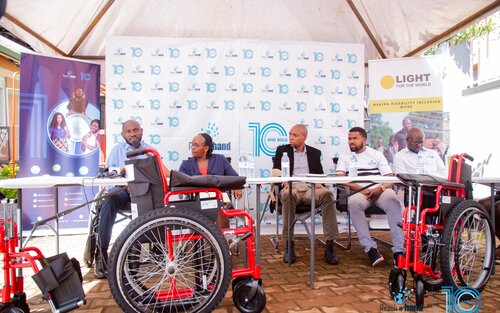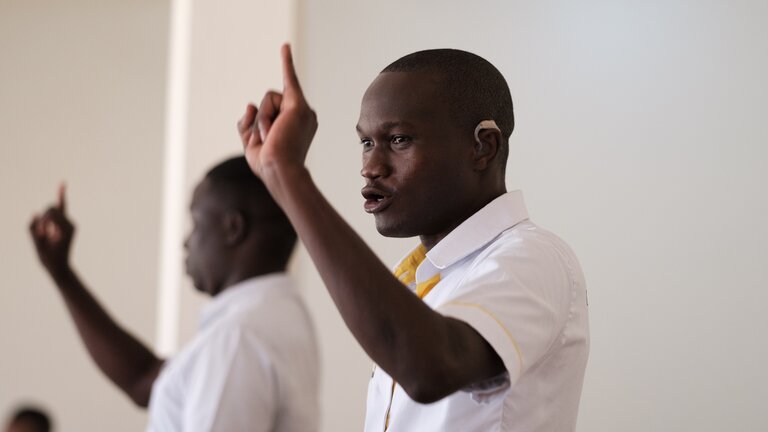Categories of Assistive Technology for Persons with Disabilities
It is important to note that assistive technology is not a cure for disability. However, it can help people with disabilities to live more independent and fulfilling lives. By providing access to assistive technology, we can help to create a more inclusive society for people with disabilities.

a group of people from Reach a hand Uganda and Light for the World sitting in a tent with wheelchairs in front of them (Reach a Hand Uganda)
Through increased independence and productivity, persons with disabilities can be physically, socially, academically, recreationally, and vocationally integrated into the community. Persons who cannot speak may use a communication device to express their needs. A person with vision impairment may use a computer screen reading software programme to continue learning. A scholar with a physical disability may use the computer software, instead of a paper and pencil, to study or carry out research.
-
Aids for Daily Living (ADL): These are devices that help people with disabilities perform basic tasks of daily living, such as eating, bathing, dressing, and using the toilet. Examples of ADLs in Uganda include wheelchairs, crutches, walkers, and raised toilet seats.
-
Bed Modification Devices (BMDs): These are devices that make it easier for people with disabilities to function in bed. Examples of BMDs in Uganda include hospital beds, side rails, and hoists.
-
Communication Aids: These are devices that help people with disabilities communicate with others. Examples of communication aids in Uganda include speech-generating devices, sign language interpreters, and text-to-speech software.
-
Computer Access Software and Hardware: This includes software and hardware that allows people with disabilities to use computers. Examples of computer access software and hardware in Uganda include screen readers, voice recognition software, and alternative keyboards.
-
Education Equipment: This includes equipment that helps people with disabilities learn and participate in school. Examples of education equipment in Uganda include adapted textbooks, magnifiers, and laptops.
-
Electronic Aids for Daily Living (EADL): These are devices that control appliances and electronic devices. Examples of EADLs in Uganda include remote controls, switchboards, and environmental control units.
-
Hearing Devices: These are devices that help people with hearing impairments hear better. Examples of hearing devices in Uganda include hearing aids, cochlear implants, and FM systems.
-
Home/Building Modifications: These are changes to homes and buildings that make them more accessible to people with disabilities. Examples of home/building modifications in Uganda include ramps, widened doorways, and accessible bathrooms.

-
Mobility/Ambulation Devices: These are devices that help people with disabilities move around. Examples of mobility/ambulation devices in Uganda include wheelchairs, crutches, walkers, and canes.
-
Prosthetics and Orthotics: These are devices that replace or support missing or malfunctioning body parts. Examples of prosthetics and orthotics in Uganda include artificial limbs, braces, and splints.
-
Recreation/Leisure Adaptations: These are modifications that allow people with disabilities to participate in recreational activities. Examples of recreation/leisure adaptations in Uganda include adapted sports equipment, accessible playgrounds, and sign language interpreters for sporting events.
-
Sitting and Positioning Modifications: These are modifications to wheelchairs and other seating systems that improve comfort and support. Examples of sitting and positioning modifications in Uganda include wheelchair cushions, headrests, and tilt tables.
-
Transportation/Driving Items: These are devices that help people with disabilities get around independently. Examples of transportation/driving items in Uganda include adapted cars, vans, and bicycles.
-
Vision Devices: These are devices that help people with visual impairments see better. Examples of vision devices in Uganda include eyeglasses, magnifying glasses, and braille displays.
These are just some of the assistive technologies that are available to people with disabilities in Uganda. The specific types of assistive technology that are available will vary depending on the individual's needs and the resources available.
